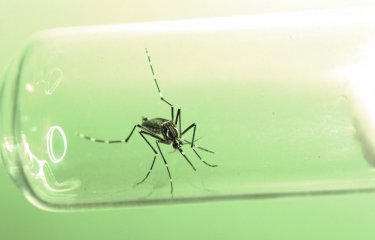Dengue virus causes an average of 500,000 hemorrhagic cases annually, posing a threat to over 2.5 billion people throughout the world every year. Scientists at the Institut Pasteur du Cambodge and the Rockefeller University working in collaboration with the Institut Pasteur (CNRS joint laboratory) have revealed that the absence of a sugar known as fucose forming the structure of anti-dengue antibodies is responsible for severe, so-called hemorrhagic forms of the disease. These severe forms mainly affect individuals who have previously contracted dengue. The detection of afucosylated anti-dengue antibodies in patients' blood at the time of hospitalization constitutes a reliable diagnostic indicator for predicting hemorrhagic forms of dengue. The results of this study were published in the June 4, 2021 issue of the journal Science.
Dengue is a viral infection transmitted to humans by mosquitoes. In its standard form, the symptoms are mild. However, its most severe form, can cause severe illness with potentially life-threatening complications.
These complications frequently occur in individuals who have previously been infected with dengue virus (DENV) and therefore already have specific antiviral antibodies. Scientists have therefore focused on characteristics of anti-dengue antibodies that potentially exacerbate disease symptoms rather than fighting the infection.
Scientists at the Institut Pasteur du Cambodge and the Rockefeller University working in collaboration with the Institut Pasteur (Paris) and the CNRS (joint laboratory UMR2000) discovered that some anti-dengue antibodies’ molecular structure is partly compromised by the absence of a sugar: fucose. The research teams demonstrated that due to this absence, anti-DENV antibodies form an excessively strong bond with white blood cells, leading to overactivation of the immune system. This results in inflammation and progression towards a severe form of the disease. These results therefore reveal the link between afucosylation and the severe form of the disease.
On analyzing plasma samples from individuals before and after infection with dengue virus, the scientists observed that levels of afucosylated antibodies were higher in patients post-infection and during convalescence. The study concluded that the detection of afucosylated anti-dengue antibodies in patients' blood at the time of hospitalization constitutes a reliable diagnostic indicator for predicting severe forms of dengue. "This detection of afucosylated antibodies is a new tool that could help with early treatment of potentially life-threatening cases," explains Tineke Cantaert, Head of the Institut Pasteur du Cambodge Immunology Unit and co-last author of the study.
"There is still no specific treatment for severe dengue. An understanding of the mechanism leading to severe disease provides a starting point for developing an effective treatment," concludes, Anavaj Sakuntabhai, Head of the Functional Genetics of Infectious Diseases Unit at the Institut Pasteur in Paris.
Source
Antibody fucosylation predicts disease severity in secondary dengue infection, Science, 4 juin 2021
Stylianos Bournazos1, Hoa Thi My Vo2, Veasna Duong3, Heidi Auerswald3, Sowath Ly4, Anavaj Sakuntabhai5,6, Philippe Dussart3, Tineke Cantaert2†*, Jeffrey V. Ravetch1†*
1 Laboratory of Molecular Genetics and Immunology, The Rockefeller University, New York, NY, USA.
2 Immunology Unit, Institut Pasteur du Cambodge, Institut Pasteur International Network, Phnom Penh, Cambodia.
3 Virology Unit, Institut Pasteur du Cambodge, Institut Pasteur International Network, Phnom Penh, Cambodia.
4 Epidemiology and Public Health Unit, Institut Pasteur du Cambodge, Institut Pasteur International Network, Phnom Penh, Cambodia.
5 Functional Genetics of Infectious Diseases Unit, Department of Global Health, Institut Pasteur, Paris Cedex 15, France.
6 Centre National de la Recherche Scientifique (CNRS), UMR2000, Paris Cedex 15, France.
*Corresponding author.
† These authors contributed equally to this work.





